|
|
|
Sort Order |
|
|
|
Items / Page
|
|
|
|
|
|
|
| Srl | Item |
| 1 |
ID:
147960
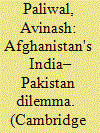

|
|
|
|
|
| Summary/Abstract |
This article seeks to examine the foreign policy behaviour of weak states in regions marked by politically turbulent geostrategic environments. An analysis of Afghanistan's foreign policy behaviour vis-à-vis Pakistan and India lends focus to this aim. India–Pakistan rivalry has gained traction as a key factor in determining Afghanistan's stability in the wake of the drawdown of Coalition forces. Missing from this debate, however, is consideration of Afghanistan's agency as a weak state with an independent set of policy preferences. Based on primary interviews with a diverse set of Afghan political actors the article outlines two competing policy advocacies: Pakistan friendly and Pakistan averse. The article argues that these advocacies are key to understanding Afghanistan's India–Pakistan dilemma. Departing from the ethnic lens used to explain Afghan politics and its regional linkages, this article shows that Kabul's relations with Islamabad determine its approach towards New Delhi regardless of ethnic rivalries. Understanding domestic Afghan narratives in this regional context is therefore imperative to adequately assess South Asia's prospective security calculus.
|
|
|
|
|
|
|
|
|
|
|
|
|
|
|
|
| 2 |
ID:
170975
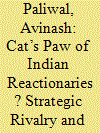

|
|
|
|
|
| Summary/Abstract |
Ostensibly driven by concerns over a military standoff with China similar to Doklam, India increased military deployment at the Myanmar tri-junction. This article assesses the inevitability of systemic factors such as rivalry with China in determining India’s approach on border issues. It asks why India sought formalization of its boundary with Burma in 1967. Given its territorial disputes with China, resolving the Burma boundary should have been high priority. Still, it took India two decades after independence to broach the subject. Based on fresh archival and interview data, this article answers the question by examining the India–Burma Boundary Agreement. A three-party territorial dispute, the making of this agreement witnessed simultaneous interplay between states with visible power differentials, and various stakeholders within India’s polity and bureaucracy. The article argues that even when inter-state competition is apparent, domestic factors may be more important in triggering foreign policy change.
|
|
|
|
|
|
|
|
|
|
|
|
|
|
|
|
| 3 |
ID:
173698
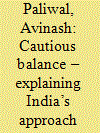

|
|
|
|
|
| Summary/Abstract |
The US president Donald Trump pitched India’s participation as being central to his Afghanistan policy in 2017. Yet, as the US has sought a negotiated settlement with the Afghan Taliban, there is little clarity on how India seeks to deal with its increasing isolation in Afghanistan. This article focuses on India’s response toward the peace talks of 2015 and 2018/19 and investigates why its position changed. In 2015, New Delhi viewed Kabul’s outreach to Pakistan as a “tilt” harmful to India’s strategic interests; in 2018/19, India sought international support for Kabul to enter dialog without preconditions. The article argues that India seeks to ensure an ongoing strategic balance between Afghanistan and Pakistan. The source of such contrasting responses to the two peace talks, then, lies in India’s perception of and confidence in the US’ approach toward Afghanistan, and the changing landscape of Afghan domestic politics.
|
|
|
|
|
|
|
|
|
|
|
|
|
|
|
|
| 4 |
ID:
170902
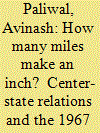

|
|
|
|
|
| Summary/Abstract |
Unabated protests in Manipur against India’s boundary with Myanmar and the lack of demarcation of some boundary pillars, despite the signing of the India-Burma Boundary Agreement in 1967, makes it an important case to study how center-state relations impact India’s foreign policy decision-making and implementation processes. Based on fresh archival material, this article explains why New Delhi refused to consult state governments in Northeast India before signing the boundary agreement, and the limiting consequences of such a top-down decision-making approach during the demarcation phase. A postcolonial entity that struggled to generate legitimacy in and assert sovereign control over the Northeast, India’s approach on this issue offers an opportunity to reflect upon the (limited) conceptualization of, and ongoing debates around, the idea of a ’state’ within foreign policy analysis.
|
|
|
|
|
|
|
|
|
|
|
|
|
|
|
|
| 5 |
ID:
151420
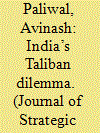

|
|
|
|
|
| Summary/Abstract |
India’s Afghanistan policy in the 1990s is termed a zero-sum game of influence with Pakistan. New Delhi’s aversion to the pro-Pakistan Taliban regime is considered a marker of this rivalry. This paper revisits India’s approach towards Afghanistan and examines if New Delhi was necessarily averse to engaging with pro-Pakistan political factions during 1990s. Based on fresh primary interviews with former Indian policymakers, media archives, and official reports, the paper shows that India engaged with and accommodated pro-Pakistan factions after the Soviet withdrawal in 1989 until 1996. The Taliban’s rise to power in Kabul in September 1996 challenged India’s engage-with-all approach. Nonetheless, the decision to sever ties with the Taliban and to bolster anti-Taliban factions was highly debated in New Delhi. Many in India saw the Taliban as a militant Islamist force sponsored by Pakistan. For others, however, it was an ethno-nationalist movement representing Pashtun interests, and not necessarily under Islamabad’s control.
|
|
|
|
|
|
|
|
|
|
|
|
|
|
|
|
| 6 |
ID:
155844
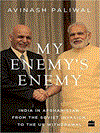

|
|
|
|
|
| Publication |
Noida, HarperCollins Publishers, 2017.
|
| Description |
xviii, 381p.hbk
|
| Standard Number |
9789352772681
|
|
|
|
|
|
|
|
|
|
|
|
Copies: C:1/I:0,R:0,Q:0
Circulation
| Accession# | Call# | Current Location | Status | Policy | Location |
| 059216 | 327.540581/PAL 059216 | Main | On Shelf | General | |
|
|
|
|
|
|
|
|
|